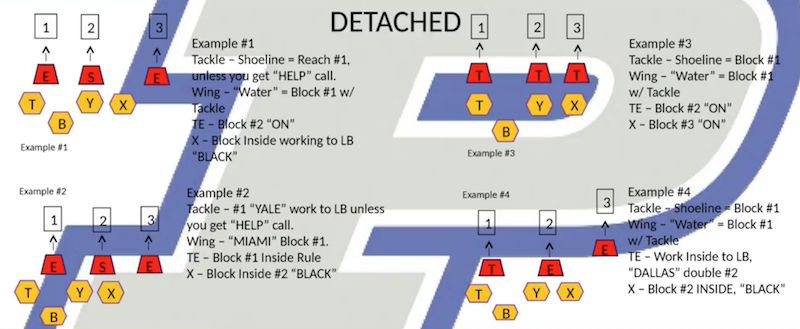Jason Strickland’s Buck Sweep from the Gun
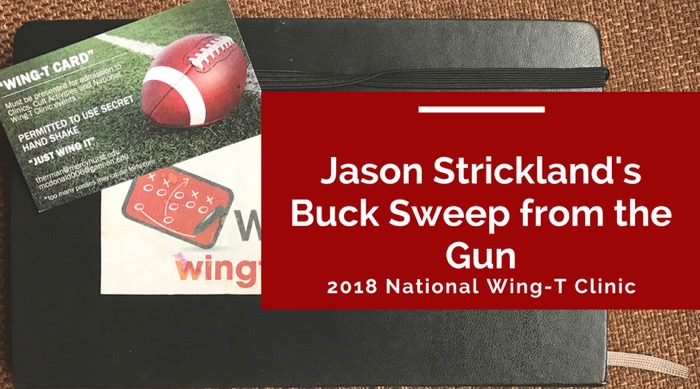
Jason Strickland was a great speaker at this year’s National Wing-T Clinic. He was dynamic, opinionated, funny, and challenged the audience to be creative in how they approach their Wing-T offense.
His mantra is “ways not plays”: Run the same plays in different ways. It is a lot easier to teach a kid to stand in a new place to run the same play than it is to learn a new rule.
The first of his talks that I attended was on running the buck sweep from the gun. While this was a focus of his talk, I would characterize it a bit more broadly: how Coach Strickland approaches the Wing-T in terms of formations and wrinkles when running from the gun, with a mindset of viewing the quarterback as one of your running backs.
Basic Alignment
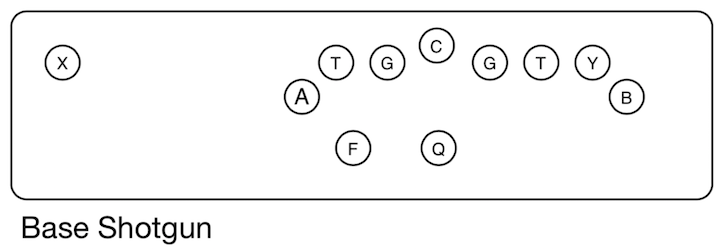
Jason’s starting and base alignment is shown above. It looks like a base Wing-T, with double wings and the fullback in the dive back position. With a running quarterback this threatens both flanks (via the two wings) as well as the traditional trap and counter games.
He likes to “sugar huddle” and will even use two TEs sometime to keep the defense guessing on where strength is (one TE will still go out to X position).
Buck Sweep Rules
Coach Strickland uses a non-traditional approach to blocking the buck sweep. Rather than strict rules, he follows the outside count approach combined with a range of calls that can be made by point-of-attack players. I would describe his approach as being more reach-block oriented rather than down block. Here are some rule and alignment basics:
- BST lines up foot-to-foot with the BSG. His job is to cut the backside A gap.
- BSG pulls to play-side and looks for a 3rd level player to block. He uses the skip-pull technique for this player.
- Center reaches play-side A gap and looks to block a backside LB.
- PSG pulls and kicks out the force player. If he has a man directly on him to outside shade, will yell help which is an alert to the PST.
- PST rule is man ON, though with a help call will block down.
- TE(Y) will call Miami if there’s a man inside his shoe line (including heads up), otherwise he calls Yale. Miami means the Y is going to block #1.
- Play-side WB listens for the TE call: Yale call means block the #1 player (via outside count rules). This could be either a down or reach block. If no Yale call, then the call is probably Miami which means he will block the man inside his shoe line. They also have a Black call in this situation which I believe has the WB go straight to backer and they will kick out the player outside shade on the TE instead of having the wing down block him. This would be similar to the wing rule on the Down play.
- The FB is the ball carrier. He mainly needs to be alert to the Black call which will move his hole inside 3–5 yards.
He likes to run this as an option for the QB, so the following rules are in effect:
- The backside wing blocks #2 anticipating the QB keep.
- The QB reads #1 on the backside with the option to keep the ball.
- X runs a hitch which could evolve into an RPO.
Variations
Some wrinkles Coach Strickland likes to use:
- He will use counter motion with the wing against the buck sweep flow. He teaches the wing to turn shoulders to QB as he goes by.
- They can “call” the QB option with a Boston call. This might be a way to work an inexperienced QB into this play so that he only needs to read and keep when it is a designed play call.

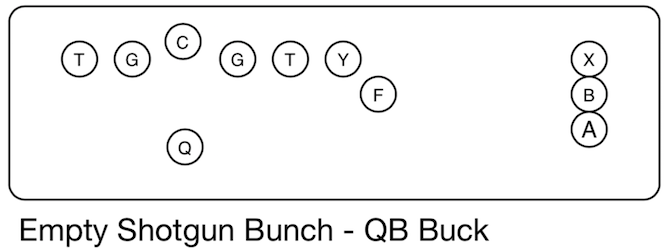
- The diagrams above show how they will run buck from empty, with the QB as the ball carrier. They run this as an RPO: either through the bubble or run buck sweep. FB obviously takes on the wing blocking assignment. When using the bunch formation, he likes to move the bunch just outside the hash instead of all the way at the numbers. This shortens the bubble throw.
- They have a steal call which they will make when a corner is cheating up on the wing (see the formation at the top - not as likely to see a corner playing on the wing when the X isn’t “over”). They have the C and PST block back and the wing releases on a quick vertical route.
Detached Formations
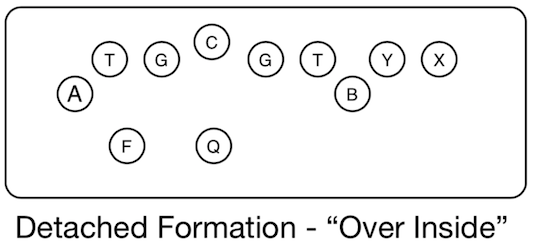
Finally, I’ll show a detached formation they will use. It is a way to play with the defense and see how they line up, possibly allowing you to find a bubble or similar weakness. I don’t have a great grasp on the rules and nuances here, but I’ll leave you with a screenshot of one of his presentation guides below.
